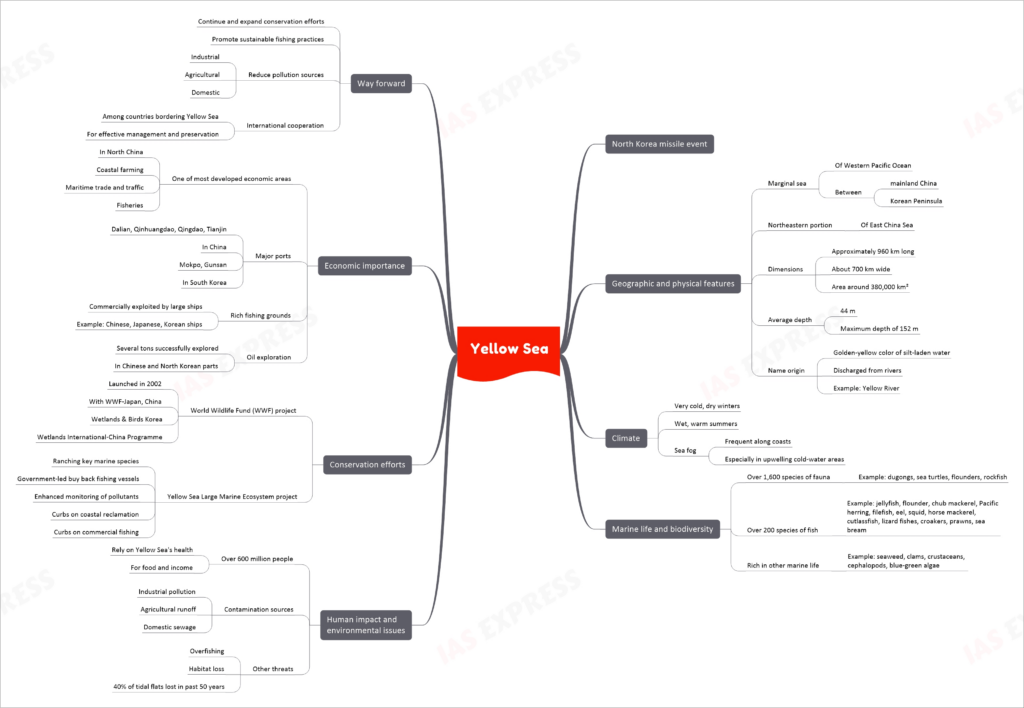Yellow Sea – Geography, Climate, Issues
Recently, North Korea fired several cruise missiles into the Yellow Sea, situated between China and the Korean Peninsula. This event has brought attention to the Yellow Sea, a significant body of water in the region.
Geography and Physical Features
- The Yellow Sea is a marginal sea of the Western Pacific Ocean, located between mainland China and the Korean Peninsula.
- It is part of the northeastern portion of the East China Sea.
- The sea is approximately 960 km (600 mi) long from north to south and about 700 km (430 mi) from east to west, with an area of around 380,000 km² (150,000 sq mi).
- The average depth of the Yellow Sea is 44 m (144 ft), with a maximum depth of 152 m (499 ft).
- The sea gets its name from the golden-yellow color of the silt-laden water discharged from major rivers, such as the Yellow River.

Climate
- The Yellow Sea has a climate characterized by very cold, dry winters and wet, warm summers.
- Sea fog is frequent along the coasts, especially in upwelling cold-water areas.
Marine Life and Biodiversity
- The Yellow Sea is home to over 1,600 different species of fauna, including dugongs, sea turtles, flounders, and rockfish.
- Over 200 species of fish inhabit the Yellow Sea, such as jellyfish, flounder, chub mackerel, Pacific herring, filefish, eel, squid, horse mackerel, cutlassfish, lizard fishes, croakers, prawns, and sea bream.
- The sea is also rich in seaweed, clams, crustaceans, cephalopods, and blue-green algae.
Human Impact and Environmental Issues
- More than 600 million people, or 10% of the global population, live on or near the shores of the Yellow Sea and rely on its health for food and income.
- Industrial pollution, agricultural runoff, and domestic sewage have contaminated the Yellow Sea’s coastal waters and habitats.
- Overfishing and habitat loss are other serious threats facing the region, with about 40% of the sea’s tidal flats having been lost in the past 50 years.
Conservation Efforts
- In 2002, the World Wildlife Fund (WWF) launched a joint project with WWF-Japan and China, Wetlands & Birds Korea, and the Wetlands International-China Programme to conserve biodiversity in the Yellow Sea.
- The Yellow Sea Large Marine Ecosystem project has introduced innovative solutions such as ranching key marine species for reintroduction, government-led schemes to buy back fishing vessels, enhanced monitoring of pollutants, and curbs on coastal reclamation and commercial fishing.
Economic Importance
- The Yellow Sea is one of the most developed economic areas in North China, with coastal farming, maritime trade and traffic, and fisheries.
- Several major ports are located along the Yellow Sea, including Dalian, Qinhuangdao, Qingdao, and Tianjin ports in China, and Mokpo and Gunsan in South Korea.
- The rich fishing grounds of the Yellow Sea have been commercially exploited by large Chinese, Japanese, and Korean ships for many years.
- Several tons of oil have been successfully explored in the Chinese and North Korean parts of the sea.
Way Forward
To ensure the long-term health and sustainability of the Yellow Sea, it is crucial to continue and expand conservation efforts, promote sustainable fishing practices, and reduce pollution from industrial, agricultural, and domestic sources. International cooperation among the countries bordering the Yellow Sea is essential for the effective management and preservation of this vital marine ecosystem.
If you like this post, please share your feedback in the comments section below so that we will upload more posts like this.


